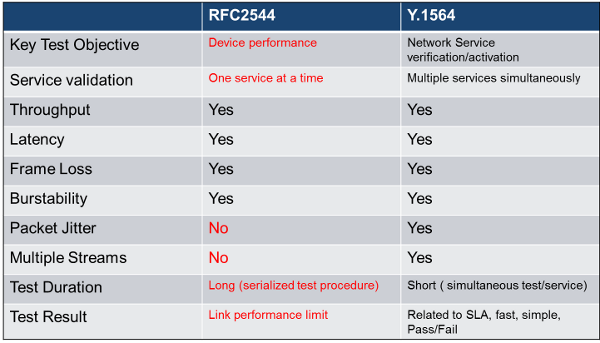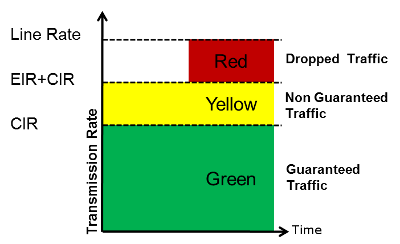V-SAM
V-SAM (VeEX Service Activation Methodology) is an automated Ethernet service activation test feature conforming to the ITU-T Y.1564 standard, created to address and solve the deficiencies of RFC 2544:
-
RFC 2544 was limited to test at the maximum throughput line rate for a single service. SAM is able to run multiple services on a single 10/100/1000 or 10G Ethernet line at a bandwidth ranging from 0 to the line rate, allowing for more realistic stream testing.
-
The Frame Delay Variation, also known as (packet) jitter was not included in RFC 2544. Jitter is a critical parameter for real time voice and video services. It is now part of the SAM test suite.
-
RFC 2544 validates the service parameters like frame loss, throughput and latency, one after the other, while SAM allows testing all the service critical parameters simultaneously. This results in significant time saving compared to RFC 2544.

Comparison of RFC 2544 and Y.1564
Test Methodology
The purpose of the SAM test suite is to verify that the service is compliant to its Bandwidth Profile and Service Acceptance Criteria. The test is broken down into two phases:
- Phase 1: Service Configuration test: The services running on the same line are tested one by one to verify the correct service profile provisioning.
- Phase 2: Service Performance test: The services running on the same line are tested simultaneously over an extended period of time, to verify network robustness.

Test Application
Phase 1: Service Configuration Test
The service configuration test is broken down into three steps. The steps are tested individually for all the services delivered on the same line.
Step 1: Committed Information Rate (CIR) Test:
Traffic is transmitted at the CIR for a short period of time and the received traffic is evaluated against the Service Acceptance Criteria (FLR, FTD, FDV) measured simultaneously. The CIR test passes if the measurements on the received traffic stay below the performance objectives.
Step 2: Excess Information Rate (EIR) Test:
Traffic is transmitted at the CIR+EIR rate for a short period of time; the EIR test passes if the received traffic rate is between the CIR (minus the margin allowed by the FLR) and CIR+EIR.
Step 3: Traffic Policing (Overshoot Test):
The purpose of the Traffic Policing Test is to ensure that when transmitting at a rate higher than the allowed CIR+EIR, the excess traffic will be appropriately blocked to avoid interference with other services. For this test, traffic is transmitted at 25% higher than the CIR+EIR for a short period of time. The test passes if the received traffic rate is at least at the CIR (minus the margin allowed by the FLR) but does not exceed the allowed CIR+EIR.
![]() At this time, the Committed Burst Size (CBS) and Excess Burst Size (EBS) tests are considered experimental and not an integral part of the standard.
At this time, the Committed Burst Size (CBS) and Excess Burst Size (EBS) tests are considered experimental and not an integral part of the standard.

Service Bandwidth Profile
Phase 2: Service Performance Test
Services running on the same line are tested simultaneously over an extended period of time, to verify network robustness. Service Acceptance Criteria (SAC) including Frame Transfer Delay (FTD), Frame Delay Variation (FDV), Frame Loss Ratio (FLR) and Availability (AVAIL) are verified for each service.